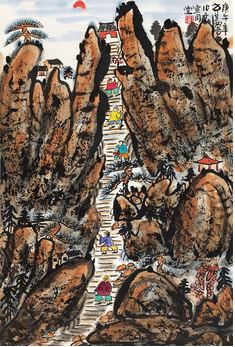Conferences
26–27 October 2017, IU China Gateway, Beijing
Call for Papers - Sacred Journeys: Pilgrimage and Religious Tourism 4th Global Conference

Please click here to view a Chinese version.
The latest research indicates that more than 400 million people embark annually on traditional pilgrimages in Saudi Arabia, India, Japan, and elsewhere, with the numbers steadily increasing. Pilgrimage is one of the most ancient practices of humankind and is associated with a great variety of religious and spiritual traditions, beliefs and sacred geographies. These include the small-scale ‘walkabout’ of Outback Australian Aborigines in search of their own and their country’s spiritual renewal, the Sufi journey to the Mausoleum of Sidi Shaykh in the Algerian West Sahara, or to Lourdes in France, which welcomes over five million Catholic pilgrims each year in search of healing or deliverance.
For some, pilgrimage is prescribed, as with the Hajj, one of the Five Pillars of Islam. In other settings, pilgrimage is more akin to religious or heritage tourism, as in China, where millions of people visit imperial mountains like Tai Shan or cultural sites such as Huang Shan (Yellow Mountain). Adoration by influential poets, painters, and philosophers over thousands of years has turned this latter site into a modern-day place of pilgrimage of international repute. One question that might be addressed at this conference is whether the overdevelopment of such significant places poses a threat to their sustainability.
Anthropologist Victor Turner once wrote that every tourist is part pilgrim, and every pilgrim is part tourist. Tourists and pilgrims are often described as being at either end of a continuum, with the former representing the leisure/pleasure seeker and the latter seeking communion with a deity. While Confucius described tourism as a fruitful practice that was good for the promotion of one’s virtues, the objective of pilgrims is often spiritual in nature. Some pilgrims will seek a vision of the deity, perform penance, obtain blessings, ask for children or cures, or pray for a long life or avert calamities, etc.
Today, apart from such religious motives, people will visit sacred sites out of curiosity or simply for peace of mind in their fast-paced existence. Some hope to validate their knowledge of ancient practices, while still others know something is missing in their lives, something not found in the materialism that the world offers as a cure-all. The religious tourism industry refers to the development of religious or spiritual sites as tourist destinations, attracting pilgrims for the purposes of worship, and also non-religious people, for sightseeing, heritage, and cultural practices. In this conference, speakers may address any aspect of this growing phenomenon.
This conference is the fourth in the series on sacred journeys, with the first two held at Oxford University’s Mansfield College and the third in Prague. As in previous gatherings, we will explore the practice of pilgrimage and religious tourism in global perspective from every conceivable angle, including the similarities and differences in the practice in Islam, Hinduism, Buddhism, Christianity, Taoism, and other traditions, and secular pilgrimage. The impact of the internet and globalization, pilgrimage as protest, and pilgrimage and peace building, etc. are potential topics, as is the concept of the internal pilgrimage and the journey of self-discovery. The experiential, practical, historical, and psychological aspects of the sacred journey are central to our exploration, and we encourage all those seeking to participate to consider their work in this larger frame. From the perspective of religious tourism, we seek papers discussing both theory and practice, motivations, media and technology, culture and heritage, the management of sacred sites, cultures as tourist products, tourism and commodification of culture, etc.
What to Send, What to Keep in Mind, and Who to Send to
Proposals in English should address the aforementioned themes, as well as related ones. Proposals with a maximum of 300 words in Microsoft Word (.doc or .docx) format should be submitted by email no later than June 1, 2017. They should include:
- Author(s)
- Affiliation
- Email address
- Title of Proposal
- Body of Proposal
- Keywords (up to 10)
Times New Roman 12 should be used for the entire proposal, without any footnotes, special formatting, characters, or emphasis. The subject line of the email should read: Sacred Journeys 4 Proposal Submission. Proposals (and correspondence) should be sent to Dr. Ian S McIntosh of Indiana University—Purdue University Indianapolis ([email protected]) and Prof Chadwick Co Sy Su of the University of the Philippines Manila ([email protected]). We acknowledge receipt and respond to all proposals submitted, which are then reviewed by at least two members of the conference committee. Upon approval of the proposal, a draft paper (maximum of 5000 words) is requested by September 15, 2017. Final papers will be considered for a special issue of the International Journal of Religious Tourism and Pilgrimage.
Registration fees are as follows: USD100 for international participants, USD50 for Chinese participants, USD50 for international students, and USD25 for Chinese students.
Conference sponsors: Indiana University; IUPUI School of Physical Education and Tourism Management; IUPUI Department of Religious Studies; University of the Philippines Manila Department of Arts and Communication.
Venue: Indiana University (IU) China Gateway – Beijing, China
Office B601D, 6th Floor, Block B CERNET Tower, Tsinghua Science Park, Building 8
No. 1 Zhongguancun East Road, Haidian District, Beijing 100084 P.R. China




